初中-中考-句子成分详解及练习
【英语】中考英语句子结构与成分基础练习题含解析
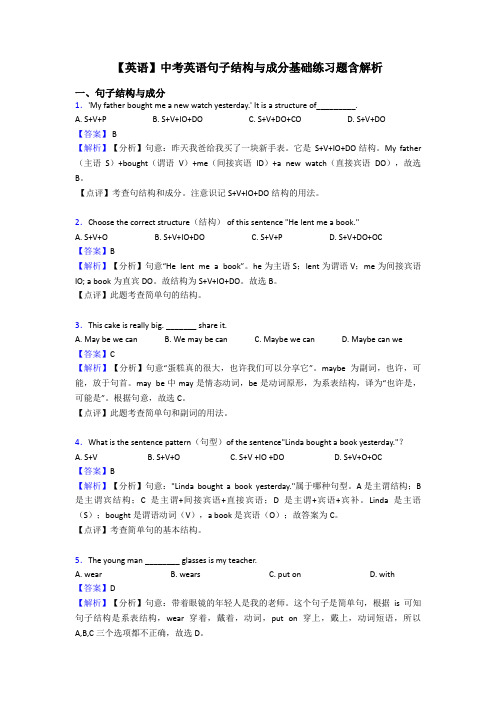
【英语】中考英语句子结构与成分基础练习题含解析一、句子结构与成分1.'My father bought me a new watch yesterday.' It is a structure of_________.A. S+V+PB. S+V+IO+DOC. S+V+DO+COD. S+V+DO【答案】 B【解析】【分析】句意:昨天我爸给我买了一块新手表。
它是S+V+IO+DO结构。
My father (主语S)+bought(谓语V)+me(间接宾语ID)+a new watch(直接宾语DO),故选B。
【点评】考查句结构和成分。
注意识记S+V+IO+DO结构的用法。
2.Choose the correct structure(结构) of this sentence "He lent me a book."A. S+V+OB. S+V+IO+DOC. S+V+PD. S+V+DO+OC【答案】B【解析】【分析】句意“He lent me a book”。
he为主语S;lent为谓语V;me为间接宾语IO; a book为直宾DO。
故结构为S+V+IO+DO。
故选B。
【点评】此题考查简单句的结构。
3.This cake is really big. _______ share it.A. May be we canB. We may be canC. Maybe we canD. Maybe can we 【答案】C【解析】【分析】句意“蛋糕真的很大,也许我们可以分享它”。
maybe为副词,也许,可能,放于句首。
may be中may是情态动词,be是动词原形,为系表结构,译为“也许是,可能是”。
根据句意,故选C。
【点评】此题考查简单句和副词的用法。
4.What is the sentence pattern(句型)of the sentence"Linda bought a book yesterday."?A. S+V B. S+V+O C. S+V +IO +DO D. S+V+O+OC【答案】B【解析】【分析】句意:"Linda bought a book yesterday."属于哪种句型。
初中中考语文专题讲练:句子成分与划分主干

句子成分与划分主干知识精讲句子成分与划分主干是中考基础知识部分会涉及到的一个考点。
不仅是句子成分的判定与划分题型,在病句分析中也会运用到这一知识点。
在复杂成分的句子中学生容易分析不准确,造成主干划分失误。
本讲我们针对句子的六种成分进行逐一梳理,并讲解句子主干划分的原则与方法。
三点剖析一、要点梳理句子的成分有六种——主语、谓语、宾语、定语、状语、补语。
其中基本成分是:主语、谓语、宾语,补充成分是:定语、状语、补语。
句子成分的符号为主语=、谓语-、宾语~、定语()、状语[ ]、补语< >,主语部分和谓语部分之间可用‖划开。
一般完整的句子成分排列归纳为:(定语:修饰主语)主语+(状语)谓语(补语)+(定语:修饰宾语)宾语(补语)(一)主语1.多表示人或事物。
作为被陈述的对象,在句首能回答“谁”或者“什么”等问题。
例1:今天晚上‖特别冷。
例2:[明天这个时候],我们‖就可以走出戈壁滩了。
2.以动作、性状或事情做陈述的对象的主语句。
例如:笑‖是具有多重意义的语言。
(二)谓语是对主语的叙述、描写或判断,能回答主语“怎么样”或“是什么”等问题。
1.动词性词语经常做谓语例1:他‖[只]答应了<一声>。
例2:南海一中‖留下<过>(许多人)的梦。
2.形容词性词语也经常做谓语例1:太阳‖热烘烘的。
例2:人参这种植物,‖娇嫩<极了>。
3.主谓短语做谓语例如:这件事‖大家都赞成。
(主谓短语)主语谓语4.名词性词语做谓语(这种情况很少见,有一定的条件限制,可参考文言文中的判断句)例1:鲁迅‖浙江绍兴人。
(名词短语)主语谓语例2:她‖大眼睛,红脸蛋。
(定中短语,表容貌)主语谓语(三)宾语是动作的对象或承受者,常位于及物动词或介词后面。
宾语可由名词、代词、数词、名词化的形容词、不定式、动名词、宾语从句等来担任。
1.名词性宾语这种情况较普遍,多数动词只能带名词性宾语,如:给、读、写、讲、修建、交流、挖、交换、校对、跟随等。
中考英语 句子成分及句子结构和练习
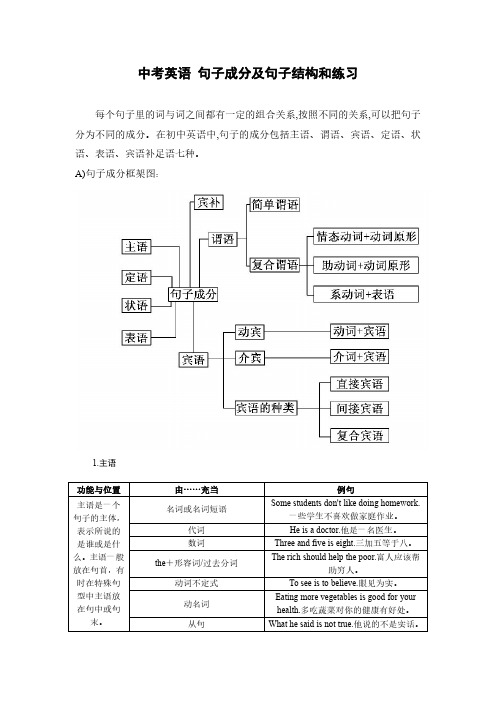
中考英语句子成分及句子结构和练习每个句子里的词与词之间都有一定的组合关系,按照不同的关系,可以把句子分为不同的成分。
在初中英语中,句子的成分包括主语、谓语、宾语、定语、状语、表语、宾语补足语七种。
A)句子成分框架图:1.主语功能与位置由……充当例句主语是一个句子的主体,表示所说的是谁或是什么。
主语一般放在句首,有时在特殊句型中主语放在句中或句末。
名词或名词短语Some students don't like doing homework.一些学生不喜欢做家庭作业。
代词He is a doctor.他是一名医生。
数词Three and five is eight.三加五等于八。
the +形容词/过去分词The rich should help the poor.富人应该帮助穷人。
动词不定式To see is to believe.眼见为实。
动名词Eating more vegetables is good for your health.多吃蔬菜对你的健康有好处。
从句What he said is not true.他说的不是实话。
(一)用横线画出下列句中主语的中心词。
1.The teacher with two of his students is walking into the classroom.2.There is an old man coming here.3.The useful dictionary was given by my mother last year.4.To do today's homework without the teacher's help is very difficult.2.谓语功能与位置由……充当例句谓语表述主语的行为动作或所处的状态,常位于主语之后,有人称、时态、语态、数的变化。
动词She practises playing the piano everyday.她每天练习弹钢琴。
初中英语句子结构成份讲解及专项练习(含答案)
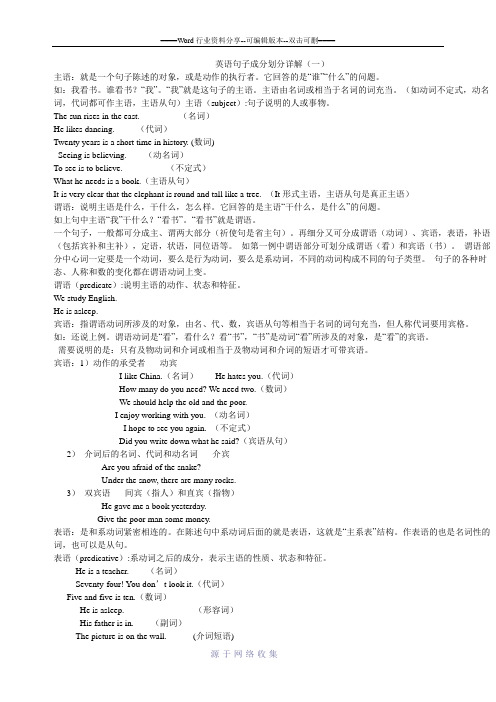
英语句子成分划分详解(一)主语:就是一个句子陈述的对象,或是动作的执行者。
它回答的是“谁”“什么”的问题。
如:我看书。
谁看书?“我”。
“我”就是这句子的主语。
主语由名词或相当于名词的词充当。
(如动词不定式,动名词,代词都可作主语,主语从句)主语(subject):句子说明的人或事物。
The sun rises in the east. (名词)He likes dancing. (代词)Twenty years is a short time in history. (数词)Seeing is believing. (动名词)To see is to believe. (不定式)What he needs is a book.(主语从句)It is very clear that the elephant is round and tall like a tree. (It形式主语,主语从句是真正主语)谓语:说明主语是什么,干什么,怎么样。
它回答的是主语“干什么,是什么”的问题。
如上句中主语“我”干什么?“看书”。
“看书”就是谓语。
一个句子,一般都可分成主、谓两大部分(祈使句是省主句)。
再细分又可分成谓语(动词)、宾语,表语,补语(包括宾补和主补),定语,状语,同位语等。
如第一例中谓语部分可划分成谓语(看)和宾语(书)。
谓语部分中心词一定要是一个动词,要么是行为动词,要么是系动词,不同的动词构成不同的句子类型。
句子的各种时态、人称和数的变化都在谓语动词上变。
谓语(predicate):说明主语的动作、状态和特征。
We study English.He is asleep.宾语:指谓语动词所涉及的对象,由名、代、数,宾语从句等相当于名词的词句充当,但人称代词要用宾格。
如:还说上例。
谓语动词是“看”,看什么?看“书”,“书”是动词“看”所涉及的对象,是“看”的宾语。
需要说明的是:只有及物动词和介词或相当于及物动词和介词的短语才可带宾语。
初一语文句子成分分析练习题及答案

初一语文句子成分分析练习题及答案一、请分析下列句子的成分,并标明主谓宾:1. 他们在公园玩耍。
主语:他们谓语:玩耍宾语:无2. 小猫睡觉了。
主语:小猫谓语:睡觉了宾语:无3. 她买了一件漂亮的衣服。
主语:她谓语:买了宾语:一件漂亮的衣服4. 学生们正在上课。
主语:学生们谓语:正在上宾语:课5. 我给你准备了礼物。
主语:我谓语:准备了宾语:礼物间宾:你二、请分析下列句子的句子成分,并标明主谓宾、定状补:1. 天空中出现了彩虹。
主语:天空中谓语:出现了宾语:彩虹2. 奶奶一边看电视,一边照顾我们。
主语:奶奶谓语:照顾宾语:我们定语:一边看电视,一边3. 孩子们高兴地玩耍着。
主语:孩子们谓语:玩耍着定状补:高兴地4. 他给我讲了一个有趣的故事。
主语:他谓语:讲了宾语:一个有趣的故事间宾:我5. 队员们紧张地等待着比赛的开始。
主语:队员们谓语:等待着定状补:紧张地宾语:比赛的开始三、请分析下列句子的句子成分,并标明主谓宾、定状补:1. 我们在夜晚中默默祈祷。
主语:我们谓语:祈祷定状补:默默宾语:无2. 妈妈疼爱我们的同时,也要求我们努力学习。
主语:妈妈谓语:疼爱定状补:同时宾语:我们宾语补足语:要求我们努力学习3. 雪花飘飘,像白色的蝴蝶。
主语:雪花谓语:飘飘宾语:无定状补:像白色的蝴蝶4. 老师认真地给我们上了一堂有趣的课。
主语:老师谓语:给上了定状补:认真地宾语:一堂有趣的课间宾:我们5. 我们每天在爸爸妈妈的陪伴下长大。
主语:我们谓语:长大定状补:每天、在爸爸妈妈的陪伴下宾语:无陪伴:爸爸妈妈以上是初一语文句子成分分析的练习题及答案,希望对你的学习有所帮助。
通过分析句子的各个成分,可以更好地理解句子的结构和意义。
请继续加强练习,提高对语文知识的掌握水平。
加油!。
初二初中英语句子成分讲解_练习及答案
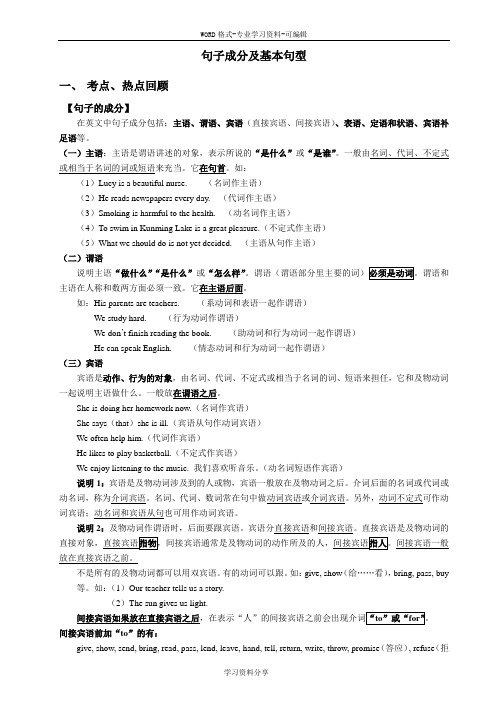
句子成分及基本句型一、考点、热点回顾【句子的成分】在英文中句子成分包括:主语、谓语、宾语(直接宾语、间接宾语)、表语、定语和状语、宾语补足语等。
(一)主语:主语是谓语讲述的对象,表示所说的“是什么”或“是谁”。
一般由名词、代词、不定式或相当于名词的词或短语来充当。
它在句首。
如:(1)Lucy is a beautiful nurse. (名词作主语)(2)He reads newspapers every day. (代词作主语)(3)Smoking is harmful to the health. (动名词作主语)(4)To swim in Kunming Lake is a great pleasure.(不定式作主语)(5)What we should do is not yet decided. (主语从句作主语)(二)谓语说明主语“做什么”“是什么”或“怎么样”。
谓语(谓语部分里主要的词)必须是动词。
谓语和主语在人称和数两方面必须一致。
它在主语后面。
如:His parents are teachers. (系动词和表语一起作谓语)We study hard. (行为动词作谓语)We don’t finish reading the book. (助动词和行为动词一起作谓语)He can speak English. (情态动词和行为动词一起作谓语)(三)宾语宾语是动作、行为的对象,由名词、代词、不定式或相当于名词的词、短语来担任,它和及物动词一起说明主语做什么。
一般放在谓语之后。
She is doing her homework now.(名词作宾语)She says(that)she is ill.(宾语从句作动词宾语)We often help him.(代词作宾语)He likes to play basketball.(不定式作宾语)We enjoy listening to the music. 我们喜欢听音乐。
(英语)中考英语初中英语句子结构与成分解题技巧讲解及练习题(含答案)

(英语)中考英语初中英语句子结构与成分解题技巧讲解及练习题(含答案)一、句子结构与成分1."Those sweet memories of summer days are about quiet streams and trees and shade." The main structure of the sentence is .A. S+VB. S+V+DO+OCC. S+V+IO+DOD. S+V+P 【答案】 D【解析】【分析】句意:这些关于夏天甜美的记忆主要是宁静的溪流、树和影子。
A、S+V=Subject (主语)+Verb (谓语);B、S+V+DO+OC=主语+谓语+宾语+宾补;C、S+V+IO+DO =Subject(主语)+Verb(谓语)+Indirect object(间接宾语)+Direct object (直接宾语);D、S+V+P=subject+verb+predicate ,属于主系表结构;该句是主系表结构,主语是: Those sweet memories of summer days,系动词are+表语,即剩下的部分,用于说明主语,故选D。
【点评】考查句子结构,注意主谓宾结构的句子的用法。
2.Which of the following sentences is correct?A. He came in and sat down.B. We all like <Harry Potter>.C. When we met. He didn't say hello.D. We went out, headed for the bus stop.【答案】 A【解析】【分析】句意:下面那个句子是正确的。
A是简单句,came和sat是并列谓语,都是一般过去式,所以A正确。
B中的符号不符合英语习惯,在英语中没有书名号,表示书名时通常用斜体字形式。
(名师整理)最新部编人教版语文中考语法专题复习《句子成分划分》精讲精练

是世世代代劳动的结晶”,这句话
的主语是: ( C )
A. 这
B. 城市
C. 建
筑物
4.选出对下面句子中加横线部分分析不正确的
一项,将序号写在括号里。( B )
A.他给我带来了一小朵雏菊和一根青草。(宾语) B.人类语言的特点就在于能用变化无穷的语音,表 达变化无穷的意义。 (主语) C.这回我们没有在办公室里停留。 (状语) D.她仍然立在死海附近的山坡上。 (补语)
5.“周总理那慈祥的面容立即跃入我的眼帘
。”一句中的主语中心语是: ( B)
A . 周总理那慈祥的面容 B . 面容
C . 周总理
6.选出对下面一句话分析正确的一项( B )
一轮鲜红的太阳从东方冉冉升起来了。 A.句子的谓语中心语是“升起来”。 B.“从东方”在句中充当状语。 C.“鲜红”是定语,“起来”是宾语。 D.“一轮”和“冉冉”都是状语。
宾语在动词后面,表示动作、行为涉及的人或事 物,回答“谁”或“什么”一类问题。宾语中心语一 般是名词或代词,有时候也有主谓短语的情况。
例:1.我‖以同样的热情寻求知识,我‖希望了解(人的)心灵。 2.我‖帮助他。 3.予‖独爱莲之出淤泥而不染。 4.我‖认为他们是当代最可爱的人。
定语位于名词前面,起修饰、限制作用 ,表示人或事物性质、状态、数量、所属等 。
冲刺中考专题复习精讲精练
•句子成分分析
•
句子概念
句子是由词或短语构成的、 能够独立表达完整意思的语言单 位。每个句子都有一定的语气语 调。
句子的六种成分
• 主语、谓语、宾语
——三种主要成分
• 定语、状语、补语
——三种附属成分
• 符号:主语句子= 成谓分语 的-符号宾语 ~
第十五章句子的成分(思维导图+知识梳理+好题精炼)2022-2023初中英语中考语法归纳

第十五章句子的成分思维导图知识梳理一、句子成分概说句子的各个组成部分,叫做句子成分.英语的句子成分有:主语、谓语、表语、宾语、定语、状语、宾语补足语等.此外有些句子还带有呼唤语、感叹语、插入语,它们在句法上与句子的其他成分不发生关系,叫做独立成分.句子的成分一般由实词担任.实词有名词、代词、形容词、数词、动词和副词.虚词在句子中只起辅助和联系作用,不能做句子成分.虚词有冠词、介词、连词、助动词等.二、句子成分(一)主语主语是一句话的主题,是说话人要说明的对象,表示所谈的是“谁”或是“什么”.主语一般在谓语之前.英语里可担任主语的有名词、代词、数词、名词化的形容词、不定式(短语)、-ing分词(短语)、从句等.Beijing is the capital of China.北京是中国的首都.(名词作主语)They have lived in Beijing since 2019.自2019年以来,他们就住在北京.(代词作主语)Ten is a very important number.10是一个重要数字.(数词作主语)The rich are getting richer and the poor are getting poorer. 富者愈富,贫者愈贫.(名词化的形容词作主语) To read in the sun is bad for your eyes.太阳下看书对你的眼睛不好.(不定式“短语”作主语)Smoking is bad for you.吸烟对你有害.(-ing分词作主语)Whenever you are ready will be fine.你不论什么时候准备好都行.(从句作主语)(二)谓语1.概说谓语是说明主语“做什么”“是什么”或者“怎么样”.谓语(谓语部分里主要的词)用动词.动词常分为实义动词、连系动词、情态动词以及助动词.情态动词和助动词不能单独充当谓语,它们必须和实义动词或系动词一起构成谓语.实义动词包括及物动词和不及物动词,及物动词后面要带宾语.通常情况下,谓语位于主语之后.谓语和主语在“人称”和“数”两方面必须一致.谓语有简单谓语和复合谓语之分.(1)简单谓语.简单谓语由一个动词或短语动词构成.它有时态、语态、语气等.She likes drawing.她喜欢画画.I had finished my homework before 9 o'clock.在9点前我已完成我的家庭作业.(2)复合谓语.①由“连系动词+表语”构成复合谓语.The game is very boring.这场比赛真没劲.②由“情态动词+动词原形”构成复合谓语.She can swim very fast.她游泳游得很快.2.谓语和主语的一致一个句子的谓语动词与主语必须在人称和数上保持一致,规则如下:(1)主语是单数必须跟单数形式的动词,主语是复数必须跟复数形式的动词.He is a friend of mine.他是我的一个朋友.(2)两个或两个以上的单数名词由and连接起来作并列主语时,谓语动词用复数.You,he and I arr all students.我、你和他都是学生.He and I like green tea.我和他都喜欢绿茶.点拨(1)用and连接的两个名词如果表示一个整体,谓语动词仍用单数形式.Bacon and eggs was served.火腿和蛋端了上来.Fork and knife was used instead of chopsticks.用刀叉而不是用筷子.(2)有every或each修饰的单数名词并列时,谓语动词用单数形式.第二个every或each可省略.Every hour and(every)minute is important.每一小时,每一分钟都很重要.Each man and(each)woman has a seat.每位男士和女士都就座了.(3)主语是单数,后面有其他干扰的成分如with,together with,along with,aswell as,no less than,like,but,except等短语时,仍和单数形式的谓语动词连用.The teacher,as well as the pupils,is doing morning exercises.老师和学生在做早操.A woman with a baby is coming to the hospital.一个妇女抱着一个婴儿正向医院走来.(4)当两个主语由or,either...or,neither...nor或not only...but also等连接时,谓语动词应和最邻近的主语一致.His parents or his sister often helps him.要么是他父母要么是他姐姐(妹妹)常帮助他.Either Tim or hs brothers have to tidy the room.不是蒂姆,就得是他的兄弟们去打扫房间.Neither the teacher nor the students know the answer.老师和学生都不知道答案.Not only the pupils but also the teacher is going to the cinema.不但学生们,而且连老师也要去看电影.(5)有些集体名词,如:people,police,youth,cattle等用作主语时,谓语动词用复数形式.The police are looking for the missing child.警察在寻找失踪的儿童.People standing there are talking about the bad news.站在那边的人正在议论那个坏消息.Catle arr also kept.还养牛.点拨但people作“民族”解时,作单数用.The Chinese people is a great people.中华民族是一个伟大的民族.(6)有些名词以“s”结尾,但却是单数.如:news,physics,maths,politics等.所以谓语动词应用单数形式.What's the news?这消息是什么?Physics is not very easy to learn.物理不很容易学.Maths is not easy to learn.数学不容易学.(7)在由here和there引起的句子中,如有两个或两个以上的主语,谓语动词通常和最邻近be的那个名词一致.Here are some envelopes and paper for you.这儿有几个信封和纸给你.There is a pen and three books on the desk.书桌上有一支钢笔,三本书.(8)集体名词作主语时,如作为整体看待,谓语动词用单数;如作为个体看待,则用复数.这类集体名词有audience(观众,听众),class(班级),committee(委员会),couple(夫妇),family(家庭),government(政府),group(小组),team(队),army(部队)等.My family is a small one.我的家庭是个小家庭.My family are listening to the radio.我家里人正在听广播.(9)each和由some,any,no,every构成的复合代词,在意义上属于单数.它们作主语时,谓语动词用单数形式.Each day is better than the one before.一天比一天好.Every student must be here on time.每个学生必须按时到这里来.(10)Chinese,French,English,Japanese等名词作主语表示语言时,用单数动词;表示人时,用复数动词.English is spoken in many countries.许许多国家讲英语.The Chinese are very friendly.中国人很友好.(11)表示时间、重量、价值、长度、距离等的复数名词作主语时,把它视作一个整体,谓语动词用单数形式.Fifty years is not a short period.50年并不是一个短时期.Twenty miles is a long way to walk.走二十英里路可是很长的一段路程.(12)a number of与the number of作主语.“a number of+复数可数名词”表示“一些”“许多”的意思,谓语动词用复数;“t he number of+复数可数名词”表示“······的数目、数量”,谓语动词用单数.A number of books are missing from the library.图书馆丢了许多书.The number of workers in this factory is increasing.这家工厂的工人数目正在增加.(三)表语是指跟在连系动词be,seem,look,sound,feel,get,smell,become等词后面的词语或从句,用以说明主语的身份、特征和状态.由名词、代词、形容词、数词、副词、动词不定式、介词短语、-ing分词、过去分词(短语)、从句等充当.You are a student.I am a student,too.你是学生,我也是学生.(名词作表语)-Who is it?是谁呀?-It's me/I.是我.(代词作表语)当人称代词作表语时,在口语中常用宾格,在正式文体中用主格.The girl is quite pretty.这个姑娘长得相当漂亮.(形容词作表语)Five plus seven is twelve.5加7是12.(数词作表语)The meeting is over.会议结束了.(副词作表语)My books are on the desk.我的书在书桌上.(介词短语作表语)My wish is to be an artist.我的愿望是成为一名艺术家.(动词不定式短语作表语)What he likes is reading novels.他的喜好是读小说.(-ing分词短语作表语)Are you excited about your new job?你对你的新工作感到高兴吗?(过去分词作表语)The question is what we should do first.问题是我们先干什么.(从句作表语)(四)宾语1.直接宾语宾语表示动作的对象或行为的承受者,用在及物动词或相当于及物动词的短语动词之后.可以作宾语的有名词、代词、数词、不定式(短语)、名词化的形容词、-ing分词(短语)、从句等.(1)名词作宾语.She is playing the piano now.她正在弹钢琴.Please open the door.请把门打开.(2)代词作宾语.She often helps us with our study.她常常帮助我们学习.We should keep these in mind.我们应该记住这些.(3)数词作宾语.I can give two.我可以给两个.I like the first.我喜欢第一个.(4)不定式(短语)作宾语.He tried to catch up with his dassmates.他设法赶上他的同学.I hate to sing.我不喜欢唱歌.(5)名词化的形容词作宾语.We should respect the old.我们应尊敬老人.The scientists may find out the unknown.科学家们可以发现未知的事物.(6)-ing分词(短语)作宾语.Return the book to the library as soon as you finish reading it.你一看完这本书就还回图书馆.He enjoys wvatching TV plays.他喜欢看电视剧.(7)从句作宾语.She said that she was busy.她说她很忙.The mother asked how her daughter was.母亲问她的女儿身体如何.2.间接宾语在英语中,有些及物动词,如bring,give,send,show,tell,teach,lend,pass等,可以有两个宾语,一个指人,一个指物,指人的叫做间接宾语,指物的叫做直接宾语,间接宾语一般放在直接宾语之前.Can you give me any information on this matter?你能给我提供这些事的任何信息吗?Write me a letter every month,please.请每月给我写封信.Please make her a model plane.请给她做个飞机模型.有时,也可以在间接宾语之前加介词to或for,构成介词短语,并把这个短语放在直接宾语之后.Mother bought the handkerchieffor you, not for me.母亲是给你,而不是给我买的手帕.I took it to the policeman on duty.我把它交给了值勤的警察.(五)定语定语是修饰名词或代词的.定语有前置定语和后置定语之分.一般来说,形容词、代词、数词、名词或名词所有格等作定语时通常放在被修饰的词之前作前置定语;而副词、介词短语、不定式短语、-ing分词短语、-ed分词短语、从句作定语时通常放在被修饰的词之后作后置定语.He said he had an important meeting to attend.他说他有一个重要会议要出席.(形容词作前置定语)This is my friend,Li Da.这是我的朋友,李达.(代词作前置定语)When I sat down, a fourth man rose to speak.我坐下后第4个人又起来发言.(数词作前置定语)We should follow the doctor's advice.我们应该听医生的嘱咐.(名词所有格作前置定语)Who is the man over there?那边的男人是谁?(副词作后置定语)A college in London had agreed to take me.最后伦敦的一所院校同意接受我.(介词短语作后置定语)Can you give me some work to do?你能给我些活儿干吗?(不定式短语作后置定语)Who is the boy dancing over there?在那儿跳舞的少年是谁呀?(-ing分词短语作后置定语)There is a little difference between written English and spoken English.书面英语和口头英语有些不同.(过去分词词组作后置定语)I hate to see letters written in pencil.我讨厌看用铅笔写的信.(-ed分词短语作后置定语)The car that's parked outside is mine.停在外面的汽车是我的.(限制性从句作后置定语)Your car, which I noticed outside, has been hit by another one.我在外面看见你的汽车了,它被另一辆车撞了.(非限制性从句作后置定语)(六)状语1.状语的表现形式状语是修饰动词、形容词、副词以及全句的句子成分.可用作状语的有副词、名词、介词短语、不定式、-ing分词、从句等.This is even better than that.这个比那个更好.(副词作状语)The coat costs 40 dollars.这件上衣值40美元.(名词作状语)She will arrive on Monday.她将于星期一到达.(介词短语作状语)To kill bugs,spray the area regularly.为了杀死臭虫,这地方要经常喷洒.(不定式作状语)They entered the room,talking and laughing.他们又说又笑地走进房间.(-ing分词作状语)She has lived alone since her husband died.自丈夫去世后她一直独自生活.(从句作状语)2.状语的分类状语按照内容可以分为时间状语、地点状语、原因状语、目的状语、结果状语、条件状语、让步状语、方式状语、程度状语、频度状语、伴随状语.What were you doing at ten last night?昨晚十点钟你在干什么?(时间状语)I met Professor Wu at the library.我在图书馆遇见了吴教授.(地点状语)Having no money,he could not buy the TV set.因为没有钱,他不能买电视机.(原因状语)In order to get into a good school, he studies hard day and night.为了考入一个好的学校,他夜以继日地苦读.(目的状语)The wind blew with such force that people could harly stand up against it.风很大,人们几乎站不住.(结果状语)I can't do it without your help.没有你的帮助,我做不成这件事.(条件状语)Whatever/No matter what I said,he refused to go.不论我说什么他都不愿走.(让步状语)He knew the country around as he knewv his own house.他了解那儿的乡村一如他了解自己的房舍.(方式状语)They are now at breakfast, talking about the plan for their trip.他们正在吃早餐,谈论着旅行计划.(伴随状语)We are very busy.我们很忙.(程度状语)作频度状语的副词always,often,usually,seldom,ever,never等一般放在实义动词之前,连系动词之后.They can hardly stay at home alone.他们几乎不单独在家.(频度状语)They are always late for school.他们总是上学迟到.(频度状语)(七)宾语补足语英语中有些及物动词,除了要有一个直接宾语外,还要带上宾语补足语,句子的意思才能完整.宾语和宾语补足语(简称宾补)一起构成复合宾语,二者之间有逻辑上的主谓关系.可以作宾补的有形容词、副词、名词、不定式(短语)、-ing分词(短语)、-ed分词(短语)、介词短语等.I made the room beautiful.我把房子拾掇得漂漂亮亮的.(形容词作宾语补足语)Keep the lights on while you are out.你不在家时,请让灯开着.(副词作宾语补足语)They named the child John.他们给孩子取名约翰.(名词作宾语补足语)What do you want me to do?你希望我为你做些什么事?(不定式短语作宾语补足语)I saw him coming last night.我昨天晚上看见他来了.(-ing分词“短语”作宾语补足语)I had my watch mended in town.我在城里修的表.(叫别人修的表)(-ed分词“短语”作宾语补足语)You should put your things in order.你应该把你的东西摆整齐.(介词短语作宾语补足语)三、独立成分(一)呼唤语称呼人的用语,称为呼语.它可位于句首,也可位于句末或句中.Hurry up,children! or we'll be late.赶快吧,孩子们!否则我们要迟到了.Shylock,how can you hope for mercy yourself when you show none?夏洛克,如果你不宽恕别人,你自己怎能希望得到别人的宽恕呢?(二)感叹语感叹语表示喜怒哀乐等感情.它多位于句首,也可放在句中或句末.常用作感叹语的感叹词有:hello,oh,well,why,alas,ch等.Here!Don'tcry!好了!别哭了!Oh,what a beautiful garden this is!啊!这是多么美丽的花园!Well,well.Here's Jack.啊唷,杰克来了.Why,it is past noon.哎呀,已经过中午了.Ah!I have never heard of such things before!啊!我以前从未听说过这种事情!点拨(1)其他词类的词也可用作感叹词,表示突然的情绪.Fire! Fire! Water! Quick! The house is on fire.着火了!着火了!水!快!房子着火了!(2)yes和no在句子里也是一种独立成分.-Do yo know Tom?你认识汤姆吗?-Yes,I do是的,我认识.(三)插入语在叙事中途往往插入一些词语,对一句话作一些附加的解释.这类词语称为插入语.它可位于句首,句中或句尾.常用的插入语有:Ithink我想,I believe我相信,I suppose 我猜想,I must admit我必须承认,in my opinion 依我看,as far as I know 据我所知,as...is concerned 就······来说,to tell you the truth 说真的,to be frank 坦率地说,in other words 换句话说,after all毕竟,of course 当然,if you don't mind 如果你不介意的话,if I may say so 如果我可以这样说的话,等.By the way,do you know the young man's name?顺便问一下,你知道那个年轻人的名字吗?That's the cheapest suit we have,I'm afraid.恐怕那是我们最便宜的西服了.I say,let's go out for a drive next Sunday.我说,咱们下星期天开车出去兜兜风吧.To be frank, I don't think you are right.坦率地说,我认为你是错的.The cross-talk,I think,was both interesting and instructive.那个相声,我觉得既有趣又能教育人.Honestly,that is all the money I have.老实说,我所有的钱就是这些.好题精练一、从下列对话中划出独立成分1.Wife:First,we need money; second,we need another baby.Husband: Sad to say,I can't trust a woman any more.2.Tom:Fire!Be quick!Bob:Nonsense(胡说)!Tom,you are dreaming!Father:Silence! Mother is sleeping. Tom: No,mother is fighting the fire!Father: Oh, my poor Tom,what a dream you've got!答案:1.First;second; Sad to say2.Fire; Nonsense; Silence; No;Oh二、用动词的适当形式填空1.His family_________ (is,are) a happy one.2.The United States_________ (are,is) to the south of Canada.3.Fifty miles_________ (is,are)a long way to walk.4.Everyone_________ (think,thinks) they are right.5.Here_________ (is,are) the news.6.John andI_________ (work,works)together.7.There_________ (is,are) five pupils in the room.8.My class_________ (are,is)going to the park.9.French_________ (are,is) spoken in many countries.10.Neither James nor Tom_________ (was,were)at home.答案:1.is2.is3.is4.thinks5.is6.work7.are8.are9.is 10.was三、翻译下列句子1.我母亲是一位医生.___________________________________________________________________________________________ _2.天空变得越来越暗了.___________________________________________________________________________________________ _3.我们要使学校变得更美丽.___________________________________________________________________________________________ _4.我发觉那本书很有趣.___________________________________________________________________________________________ _5.别再弄出噪音了.___________________________________________________________________________________________ _6.你吃过午饭了吗?___________________________________________________________________________________________ _7.她给我买了一本词典.___________________________________________________________________________________________ _8.请递给我那张纸.___________________________________________________________________________________________ _答案:1.My mother is a doctor.2.The sky is becoming darker and darker.3.We'll make our school more beautiful.4.I find the book very interesting.5.Stop making a noise.6.Have you had lunch yet?7.She bought me a dictionary/ She bought a dictionary for me.8.Please pass me the paper.。
初中英语划分句子成分详解及练习
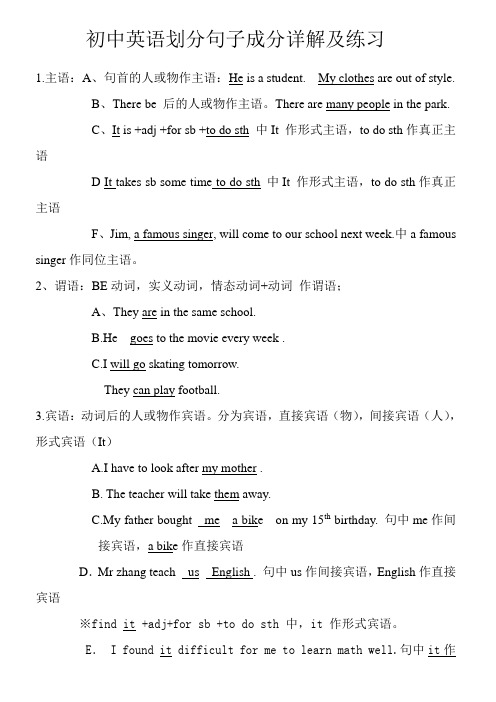
初中英语划分句子成分详解及练习1.主语:A、句首的人或物作主语:He is a student. My clothes are out of style.B、There be 后的人或物作主语。
There are many people in the park.C、It is +adj +for sb +to do sth 中It 作形式主语,to do sth作真正主语D It takes sb some time to do sth 中It 作形式主语,to do sth作真正主语F、Jim, a famous singer, will come to our school next week.中a famous singer作同位主语。
2、谓语:BE动词,实义动词,情态动词+动词作谓语;A、They are in the same school.B.He goes to the movie every week .C.I will go skating tomorrow.They can play football.3.宾语:动词后的人或物作宾语。
分为宾语,直接宾语(物),间接宾语(人),形式宾语(It)A.I have to look after my mother .B. The teacher will take them away.C.My father bought me a bike on my 15th birthday. 句中me作间接宾语,a bike作直接宾语D.Mr zhang teach us English . 句中us作间接宾语,English作直接宾语※find it +adj+for sb +to do sth 中,it 作形式宾语。
E. I found it difficult for me to learn math well.句中it作形式宾语,difficult作宾语补足语。
中考语文划分句子成分习题
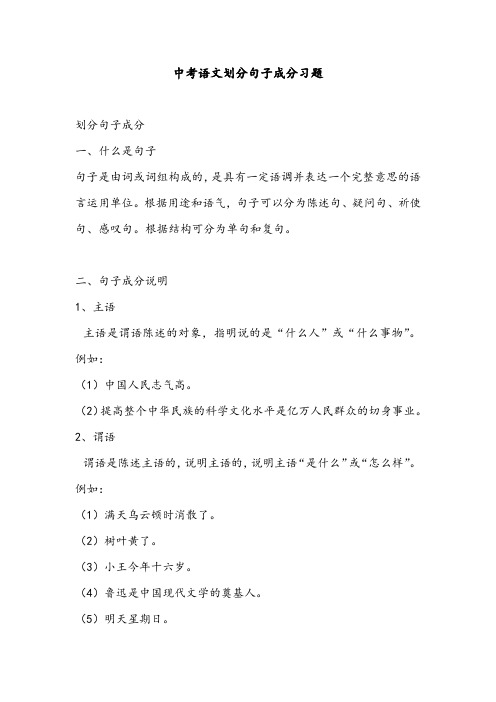
中考语文划分句子成分习题划分句子成分一、什么是句子句子是由词或词组构成的,是具有一定语调并表达一个完整意思的语言运用单位。
根据用途和语气,句子可以分为陈述句、疑问句、祈使句、感叹句。
根据结构可分为单句和复句。
二、句子成分说明1、主语主语是谓语陈述的对象,指明说的是“什么人”或“什么事物”。
例如:(1)中国人民志气高。
(2)提高整个中华民族的科学文化水平是亿万人民群众的切身事业。
2、谓语谓语是陈述主语的,说明主语的,说明主语“是什么”或“怎么样”。
例如:(1)满天乌云顿时消散了。
(2)树叶黄了。
(3)小王今年十六岁。
(4)鲁迅是中国现代文学的奠基人。
(5)明天星期日。
(6)什么书他都看。
3、宾语宾语在动语后面,表示动作、行为涉及的人或事物,回答“谁”或“什么”一类问题。
例如:(1)什么叫信息?(2)门口围着一群看热闹的。
(3)马克思认为知识是进行斗争和为无产阶级解放事业服务的手段。
4、定语定语是名语前面的连带成分,用来修饰、名词表示人或事物性质、状态、数量、所属等。
例如:(1)那(沉甸甸)的稻谷,象一垄垄(全黄)的珍珠。
(2)(三杯)美酒敬亲人。
(3)雪野中有(血红)的宝珠山茶,(白中隐青)的(单瓣)梅花。
(4)(中国)的历史有(自己)的特点。
5、状语状语是动语或形容词前面的连带成分,用来修饰、限制动词或形容词,表示动作的状态、方式、时间、处所或程度等。
例如:(1)他[已经]走了。
(2)咱们[北京]见。
(3)歌声[把王老师]带入深沉的回忆。
(4)科学[终于以伟大的不可抑制的力量]战胜了神权。
副词、形容词经常作状语,表时间、处所的名词经常作状语,一般名词不作状语。
动词中除助动词外,一般动词很少作状语,介词短语常作状语。
一般状语紧连在中心高速的前边,但表时间、处所、目的的名词或介词短语作状语时,可以放在主语的前边,如,[在杭州]我们游览了西湖胜景。
6、补语补语是动词或形容词后面的连带成分,一般用来补充说明动作、行为的情况、结果、程度、趋向、时间、处所、数量、性状等。
【中考专题分类】中考英语专题讲练 句子的基本结构和成分(含解析)

句子的基本结构和成分句子基本结构和成分知识精讲一、句子基本结构1. 主谓宾结构:“主谓宾”结构是英文表达中最基本的结构,表达“谁做了什么事”,句中的“谁”即主语;“做了”即谓语;“什么事”为宾语。
1). 主语:可以作主语的成分有名词(如boy),主格代词(如you),数词,动词不定式,动名词等。
主语一般在句首。
注意名词单数形式常和冠词不分家,如:The boy comes from America. 这个男孩来自美国。
He made a speech. 他做了演讲。
Tow and two is four. 二乘二等于四。
To be a teacher is my dream. 成为老师是我的梦想。
Doing a research is a necessary step when you write an essay.当你写论文时,做调查是很有必要的一步。
2). 谓语:谓语由动词构成,是英语时态、语态变化的主角,一般在主语之后,后接宾语。
但谓语可以是不及物动词(vi.),没有宾语,形成主谓结构,如:I have arrived. 我已经到了Many changes took place in my hometown.家乡发生了很多变化。
注:以下这些词是不及物动词:表发生、出现的,如:take place, appear, happen,break out; 表来、去,如:come, go 等3). 宾语:宾语位于及物动词之后,一般同主语构成一样,不同的是构成宾语的代词必须是宾格形式,如:me,him,them等。
除了代词宾格可以作宾语外,名词,动名词,不定式等可以作宾语,如:I will do it tomorrow. 我明天在做(这件事)。
The boy needs a pen. 这个男孩需要一只钢笔。
I like swimming. 我喜欢游泳。
I like to swim this afternoon. 我今天下午喜欢游泳。
04句子成分-初中语文语法知识精讲与专练
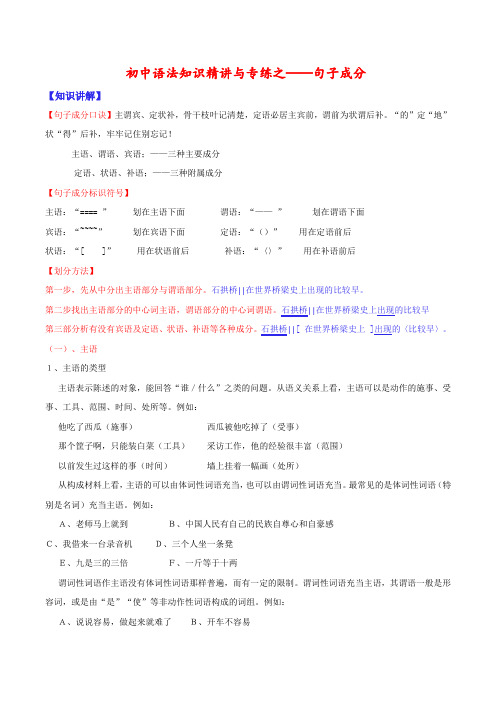
初中语法知识精讲与专练之——句子成分【知识讲解】【句子成分口诀】主谓宾、定状补,骨干枝叶记清楚,定语必居主宾前,谓前为状谓后补。
“的”定“地”状“得”后补,牢牢记住别忘记!主语、谓语、宾语;——三种主要成分定语、状语、补语;——三种附属成分【句子成分标识符号】主语:“==== ”划在主语下面谓语:“——”划在谓语下面宾语:“~~~~”划在宾语下面定语:“()”用在定语前后状语:“[ ]”用在状语前后补语:“〈〉”用在补语前后【划分方法】第一步,先从中分出主语部分与谓语部分。
石拱桥||在世界桥梁史上出现的比较早。
第二步找出主语部分的中心词主语,谓语部分的中心词谓语。
石拱桥||在世界桥梁史上出现的比较早第三部分析有没有宾语及定语、状语、补语等各种成分。
石拱桥||[ 在世界桥梁史上 ]出现的〈比较早〉。
(一)、主语1、主语的类型主语表示陈述的对象,能回答“谁/什么”之类的问题。
从语义关系上看,主语可以是动作的施事、受事、工具、范围、时间、处所等。
例如:他吃了西瓜(施事)西瓜被他吃掉了(受事)那个筐子啊,只能装白菜(工具)采访工作,他的经验很丰富(范围)以前发生过这样的事(时间)墙上挂着一幅画(处所)从构成材料上看,主语的可以由体词性词语充当,也可以由谓词性词语充当。
最常见的是体词性词语(特别是名词)充当主语。
例如:A、老师马上就到B、中国人民有自己的民族自尊心和自豪感C、我借来一台录音机D、三个人坐一条凳E、九是三的三倍F、一斤等于十两谓词性词语作主语没有体词性词语那样普遍,而有一定的限制。
谓词性词语充当主语,其谓语一般是形容词,或是由“是”“使”等非动作性词语构成的词组。
例如:A、说说容易,做起来就难了B、开车不容易C、干净最重要D、坚持说英语很有必要E、谦逊是一种美德F、虚心使人进步,骄傲使人落后。
2、时间主语和处所主语(1)时间名词、处所名词跟一般人物名词(包括代名词,下同)一样,也可作主语。
如:A、小王去了深圳(人物名词作主语)B、昨天来了一位新老师(时间名词作主语)C、屋里能住十个人(处所名词作主语)(2)时间名词或处所名词同人物名词一起出现在句法结构的开头时,人物名词作主语,时间名词或处所名词作状语。
中考语文基础考点专题复习 句子的成分及类型(一)(解析版)

专题12 句子的成分及类型(一)一、选择题1.下列句子说法正确的一项是()A.创建文明、和谐、健康、美丽的校园,是我们责无旁贷的责任。
(这个句子没有语病)B.通常的律诗每首共八句,每两句成一联,共四联,依次是:首联、颈联、颔联、尾联。
C.露珠晶莹、国旗鲜艳是主谓短语;晶莹的露珠、鲜艳的国旗是偏正短语。
D.“多么令人难忘的一节课!”;“我不知道未来将有什么奇迹发生。
”;“举手之劳,尽显素养!”这三个句子分别是感叹句、疑问句、感叹句。
【答案】C【详解】A.“责无旁贷”与“责任”语义有重复,去掉“是”和“的责任”或去掉“责无旁贷”;B. 依次是:首联、颔联、颈联、尾联;D. “我不知道未来将有什么奇迹发生。
”虽然有疑问词“什么”,却没有疑问语气,应为陈述句;故选C。
2.下列分析有误的一项是()A.“他给我拣定了靠车门的一张椅子。
”(这个句子的主干是:他拣椅子。
)B.“多么令人难忘的瞬间!”“我不知道会不会出现奇迹。
”“别在那儿发呆了!”(这三个句子依次是感叹句、疑问句、陈述句。
)C.农历新年的习俗可多啦,贴春联、挂年画、舞龙灯、放花炮、穿新衣……处处呈现祥和、热闹的氛围。
(句中标点符号使用正确。
)D.“托尔斯泰这对眼睛里有一百只眼珠。
”(句中运用了夸张的修辞手法。
)【答案】B【详解】B.“我不知道会不会出现奇迹。
”是一个陈述句,“别在那儿发呆了!”是一个祈使句。
故选B。
3.下列分析有误的一项是()A.头顶上盘着大辫子,顶得学生制帽的顶上高高耸起,形成一座富士山。
(此句运用了比喻和夸张的修辞手法)B.在朱德母亲追悼会上,中共中央的挽联是“八路功勋大孝为国,一生劳动吾党之光”。
(此句的宾语是“八路功勋大孝为国,一生劳动吾党之光”)C.她靠着大家的帮助完成了学业。
(此句的主干是“她靠着帮助”)D.母亲,您要爱惜自己的身体!(这是一个祈使句)【答案】C【详解】C.句子主干应该是“她完成了学业”。
故选C。
4.下列判断有误的一项是()A.“学校”“注视”“爷爷”“漂亮”这四个词语的词性分别是名词、动词、名词、形容词。
九年级句子成分分析练习题及答案

九年级句子成分分析练习题及答案1. 我喜欢读书。
主语:我谓语:喜欢宾语:读书2. 她正在做作业。
主语:她谓语:正在做宾语:作业3. 小明把书还给了老师。
主语:小明谓语:把...还给了宾语:书间接宾语:老师4. 咱们明天去游乐园玩吧。
主语:咱们谓语:去玩宾语:游乐园5. 那只狗又跑了出去。
主语:那只狗谓语:跑出去6. 妈妈给我买了一本漫画书。
主语:妈妈谓语:给...买了宾语:漫画书间接宾语:我7. 我们的学校有很多漂亮的花园。
主语:我们的学校谓语:有宾语:花园8. 他在公园里给小朋友们讲故事。
主语:他谓语:在...里给...讲宾语:故事间接宾语:小朋友们9. 我和朋友们一起参加了比赛。
主语:我和朋友们谓语:参加了宾语:比赛10. 学校里的食堂有很多美味的食物。
主语:学校里的食堂谓语:有宾语:食物答案解析:在以上句子中,主语是句子的核心成分,表示动作的主体或者实施者;谓语是句子的核心部分,表示行为或状态;宾语是句子中受动作影响的对象;间接宾语是一种特殊的宾语,表示受益或者受到动作影响的人或者事物。
根据句子的语法结构,我们可以准确地分析出每个句子中的成分,并且按照合适的格式进行书写。
以上是九年级句子成分分析的练习题及答案。
通过这些练习,希望能帮助同学们更好地理解句子的结构和成分,提升语文学习能力。
相信通过不断的练习和巩固,大家一定能在句子成分分析方面取得更好的成绩。
祝愿大家学习进步!。
初中英语句子结构与成分解题技巧和训练方法及练习题(含答案)
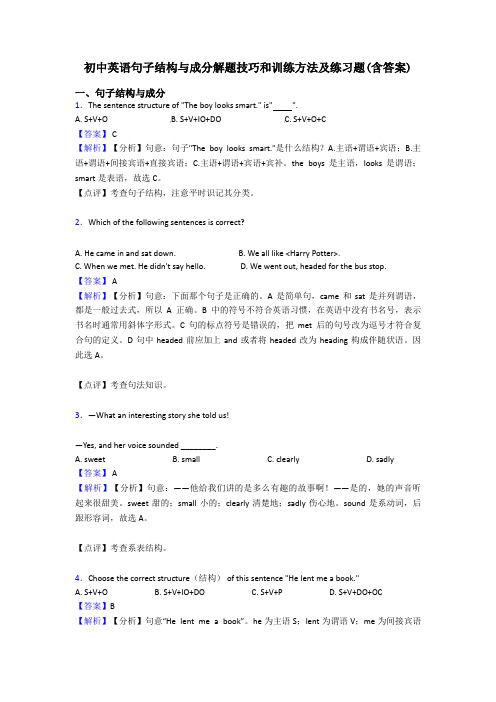
初中英语句子结构与成分解题技巧和训练方法及练习题(含答案)一、句子结构与成分1.The sentence structure of "The boy looks smart." is" ".A. S+V+OB. S+V+IO+DOC. S+V+O+C【答案】 C【解析】【分析】句意:句子"The boy looks smart."是什么结构?A.主语+谓语+宾语;B.主语+谓语+间接宾语+直接宾语;C.主语+谓语+宾语+宾补。
the boys是主语,looks是谓语;smart是表语,故选C。
【点评】考查句子结构,注意平时识记其分类。
2.Which of the following sentences is correct?A. He came in and sat down.B. We all like <Harry Potter>.C. When we met. He didn't say hello.D. We went out, headed for the bus stop.【答案】 A【解析】【分析】句意:下面那个句子是正确的。
A是简单句,came和sat是并列谓语,都是一般过去式,所以A正确。
B中的符号不符合英语习惯,在英语中没有书名号,表示书名时通常用斜体字形式。
C句的标点符号是错误的,把met后的句号改为逗号才符合复合句的定义。
D句中headed前应加上and或者将headed改为heading构成伴随状语。
因此选A。
【点评】考查句法知识。
3.—What an interesting story she told us!—Yes, and her voice sounded ________.A. sweetB. smallC. clearlyD. sadly【答案】 A【解析】【分析】句意:——他给我们讲的是多么有趣的故事啊!——是的,她的声音听起来很甜美。
初中英语句子成分分析含练习含答案

一. 主语 (1)二. 谓语 (2)三. 表语 (3)四. 宾语 (4)五. 补语 (7)六. 定语 (8)七. 同位语 (9)八. 状语 (10)句子是按照一定的语法规律组成的,表达一个完整的意义。
一个句子一般由两部分构成,即主语部分和谓语部分,这两部分也叫做句子的主要成分。
句子的次要成分包括宾语,定语,状语,表语、同位语等。
一.主语:主语(subject) 是一个句子的主题( theme),是句子所述说的主体、对象。
它的位置一般在一句之首。
可用作主语的有一个单词、短语、从句乃至句子。
1.名词作主语。
A tree has fallen across the road. (一棵树倒下横在路上。
)Little streams feed big rivers. ( 小河流入大江。
)2.代词用作主语。
He told a joke but it fell flat. (他说了个笑话,但没有引人发笑)Everybody enjoyed themselves on vacation. 假期里大家都过得很愉快。
3.数词用作主语。
如:Three is enough. 三个就够了。
Four from seven leaves three. 7减4余3。
4.名词化的形容词用作主语。
The old and the young are taken good care of in that village.5.副词用作主语(极少见)。
Now is the time. 现在是时候了。
6.名词化的介词作主语。
The ups and downs of life must be taken as they come. 我们必须承受人生之沉浮。
7.不定式用作主语。
To find your way can be a problem.你能否找到路可能是一个问题。
It is impossible to defeat a person who never gives up.要打败一个永不放弃的人是不可能的。
初三英语句子的成分试题答案及解析

初三英语句子的成分试题答案及解析1.— do you know so much about the UFO?—I usually get the information by surfing the Internet.A.How B.WhatC.Which D.Where【答案】A【解析】句意:--你是如何知道如此多的关于UFO的事情?--我经常从网络上得到信息。
分析选项:how如何;what什么;which哪一个;where在哪。
联系句意:询问得到相关信息的方式,因此用疑问词how.故选 A【考点】考查疑问词的用法。
2. -- _______ is the man in the white shirt? -- He is an engineer.A.How B.WhereC.Who D.What【答案】D【解析】句意:--穿白色衬衫的这个男子是谁?--他是一名工程师。
分析选项:how如何;where在哪; who谁;what什么。
联系答语体现对人物的职业进行提问,因此选用疑问词what.故选 D 【考点】考查疑问词的用法。
3. ---In recent years more and more Indians like traveling in Asia during May Day.--- .A.So do we Chinese B.Neither do we ChineseC.So we Chinese do D.Neither we Chinese will【答案】C【解析】句意:最近几年在五一期间,越来越多的印度人喜欢在亚洲旅行。
So+助动词/情态动词/系动词+主语:某某也如此,与上文不是同一人,如果上句是否定句,表达某某也不neither +助动词+主语;so + 主语+助动词/情态动词/系动词+主语:某某确实如此,与上文是同一人。
该句式在时态,人称上与前一个句子相同。
上句是肯定句,故选C【考点】考查固定句式。
- 1、下载文档前请自行甄别文档内容的完整性,平台不提供额外的编辑、内容补充、找答案等附加服务。
- 2、"仅部分预览"的文档,不可在线预览部分如存在完整性等问题,可反馈申请退款(可完整预览的文档不适用该条件!)。
- 3、如文档侵犯您的权益,请联系客服反馈,我们会尽快为您处理(人工客服工作时间:9:00-18:30)。
句子的成分是指组成句子的各个部分,即:主语、谓语、表语、宾语(直接宾语和间接宾语)、补足语、定语、状语等。
主要成分:主语和谓语次要成分:表语、宾语、补足语、定语、状语等一、主语:句子所叙述的主体。
一般位于句首,表示句子所说的是“什么人”或“什么事物”。
一般由名词、代词、数词、不定式、动名词、名词化的形容词和主语从句等充当。
注意:在there be结构、疑问(当主语不是疑问词时)和倒装句中,主语位于谓语动词、助动词或情态动词后面。
例如:Tom is a good boy. (名词)We often speak English in class. (代词)One-third of the students in this class are girls. (数词) Toswim in the river is a great pleasure. (不定式) Smoking doesharm to the health. (动名词)The rich should help the poor. (名词化形容词)When we are going to have a test has not been decided. (主语从句)It is n ecessary to master a foreig n Ian guage.(为形式主语,真正的主语是不定式)(二)谓语:谓语说明主语所做的动作或具有的特征和状态。
说明主语“做什么”、“是什么”或“怎么样”,一般由动词或动词短语来充当,一般放在主语之后。
谓语和主语在人称和数两方面必须一致。
谓语的构成如下:1. 简单谓语:由一个动词或动词短语构成。
如:I like apples. (动词)He practices running every morni ng. (动词短语)2. 复合谓语:(1)由(情态动词或其他助动词+动词原形)构成。
如:You may keep the book for two weeks.He has caught a bad cold.(2)由(系动词+表语)构成。
We are hav ing a quick breakfast.(三)表语:用于说明主语的性质、身份、特征和状态等,说明主语“是什么”或“怎么样”。
表语一般由名词、代词、形容词、分词、数词、不定式、动名词、介词短语、副词及从句充当。
位置:用在动词be和系动词(如keep, rema in, become, get.grow, tur n, I ook, seem, feel, smell, sound, taste等)的后面。
表语须和连系动词一起构成句子的复合谓语,即成系表结构。
My mother is a doctor. (名词)Is it yours? (代词)The weather has turned cold. (形容词)The speech is exciting. (现在分词)The door is closed. (过去分词)Three times seven is twenty one. (数词)His job is to teach English. (不定式)His hobby is playing football. (动名词)The machine must be out of order(. 介词短语)Time is up. The class is over. (副词)The truth is that he has never been abroad.(表语从句)四)宾语:表示动作的对象或承受者,一般位于及物动词和介词后面,说明主语“做什么”,由名词、代词、数词、名词化的形容词、不定式和宾语从句。
及物动词必须加宾语。
They went to see an exhibition yesterday. (名词)The heavy rain prevented me from coming to school on time. (代词)How many dictionaries do you have? I have three. (数词)They helped the old with their housework yesterday(. 名词化形容词)He pretended not to see me. (不定式)I enjoy listening to popular music. (动名词)I think (that) he is fit for this job. (宾语从句)宾语种类:< 1 > 双宾语(间接宾语+直接宾语)有的动词后面可接双宾语,包括常用来指人的间接宾语和常用来指物的直接宾语。
Lend me your dictionary, please. =Lend your dictionary to me, please.间宾直宾直宾间宾※ 这类词有bring, give, show, send, pass, tell, lend, offer, buy, make, do 等。
带双宾语的及物动词,如果把直接宾语置于间接宾语之前, 必须在变换时加“ to ”或“ for ”。
这类词可以归纳为“七给” 一“带” to不少,“买”画“制作”for 来了:1、“七给”(give, pass, lend, write, show, send, hand和“带”(bring)8个及物动词,在直接宾语前置时,必须在后面加上“to”。
即“ vt. + sth. + to + sb.” 如:He lent some money to me.类似动词的还有:get, mail, offer, pay, promise, read, sell, take, teach2、“ buy” (买);“ draw” (画);“ make” (制作)三个动词, 在直接宾语前置时,则必须在后边加“for”,构成“vt. + sth. + for+ sb.”Mother bought a new dress for me。
类似动词还有:build,choose, cook, cut, do, find, fix, leave, order等。
3、当直接宾语是代词时,间接宾语for和to于直接宾语之后。
如:Richard made it for him。
理查德为他做的这个东西Give it to me。
把它给我4、有些动词后可单独用直接宾语、间接宾语或双宾语,如ask, teach,tell, owe, pay.I asked Joh n.我问约翰I asked a questi on.我问了一个问题I asked John a question我问了约翰一个问题< 2 >复合宾语(宾语+宾语补足语),例如:They elected him their mon itor.宾语宾语补足语(五)宾语补足语:有些及物动词除了要有一个宾语之外,还须加上一个补足语。
如果没有宾补,有时候句子的意思就不完整。
用来补充说明宾语的特征、状态或身份,宾语补足语可由名词、形容词、副词、不定式、分词、介词短语和从句充当。
并与宾语一起构成复合宾语的句子成分。
带有宾语补足语的一般句型为:某些及物动词(如make, let, see, find, name等)或介词(如with)+宾语+宾补女口His father n amed him Dong Ming. (名词)They pain ted their boat white. (形容词)Let the fresh air in. (畐U词)I ask him to go home now. (不定式)We saw her entering the room. (现在分词)He foundthe door locked. (过去分词)We found everything in the lab in good order. (介词短语)We will soon make our city what your city is now. (从句)(六)定语:修饰名词或代词的词、短语或从句称为定语。
定语可由名词、形容词、代词、数词、副词、介词短语、不定式、分词等来充当。
Guilin is a beautiful city. (形容词)China is a developing country.(现在分词)America is a developed country. (过去分词)There are thirty women teachers in our school. (名词)Hismath is very good. (形容词性物主代词)I am the last personto leave the classroom. (不定式)The teaching plan for nextterm has been worked out. (动名词)He is reading an article about how to learn German.(介词短语)(七)状语:用来修饰动词、形容词、副词或整个句子,以说明地点, 时间, 方式, 程度, 原因, 目的, 结果, 条件,让步,伴随状态,比较等。
一般由副词、名词、介词短语、不定式、从句或相当于副词的词组或短语等来充当。
如:Light travels most quickly. (副词性词组)He has lived in the city for ten years. (介词短语)He is proud to have passed the college en tra nee exam in ation不定式)He is in the room making a model plane. (现在分词短语)Wait a minute. (名词)Once you begin, you must continue. (状语从句)How about meeting again at six? (表时间)Last night he didn ' g t to the dance party because of the rain表原因)I shall go there if it doesn'ra t in. (表条件)Mr. Smith lived on the third floor. (表地点)She put the eggs into the basket with great care. (表方式)She came in with a book in her hand. (表伴随状态)In order to catch up with the others, I must work harder(. 表目的)He was so tired that he fell asleep immediately. (状语从句表结果)She works very hard though she is old. (状语从句表让步)I am taller than he is. (状语从句表比较)状语的位置:1.only 在句中的位置比较灵活, 但位置不同, 意义也不同.The actor only sang a song.Only the actor sang a song.The actor sang only one song.2. 两个或多个状语同时修饰时的顺序1)地点状语在前, 时间状语在后.We will have a meeting in Room 202 tomorrow.2)较小单位的状语在前,由小到大Mr. Li lives at 88 Chongwen Rd., Suzhou, Jiangsu.3)一个句子有几个不同种类的副词作状语, 其顺序大都是: 程度副词,方式副词, 地点副词, 时间副词She sang very well at the meeting last night.3. 时间和地点状语也可以位于句首, 表示强调或使上下文更为连贯Usually I read the newspapersin the morning, but yesterday I readthem in the evening.(八)独立成分:与全句没有语法关系的句子成分叫做句子的独立成分感叹词:oh, hello, aha, ah, 等。
